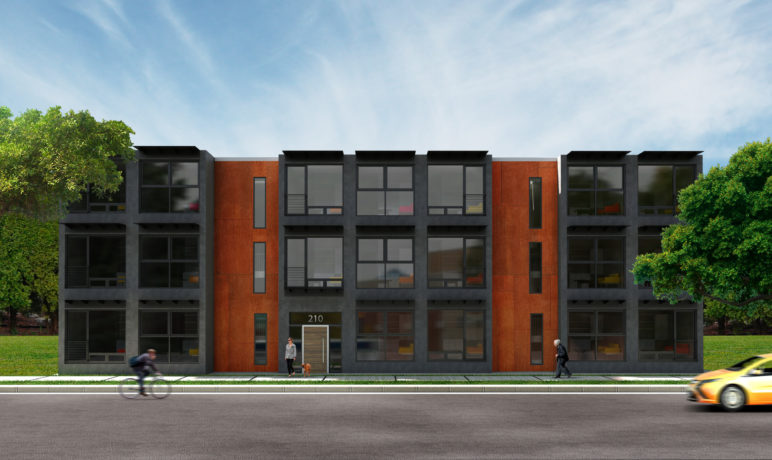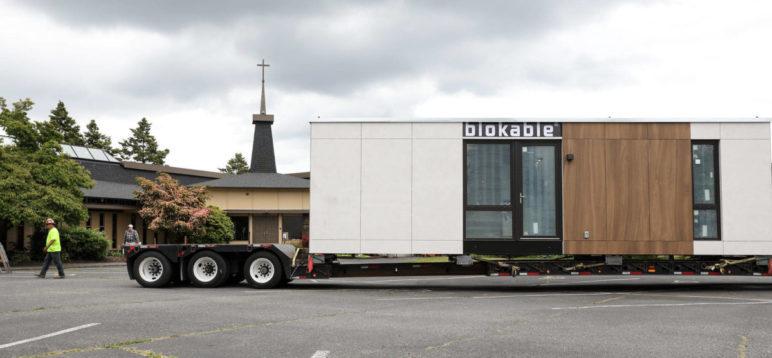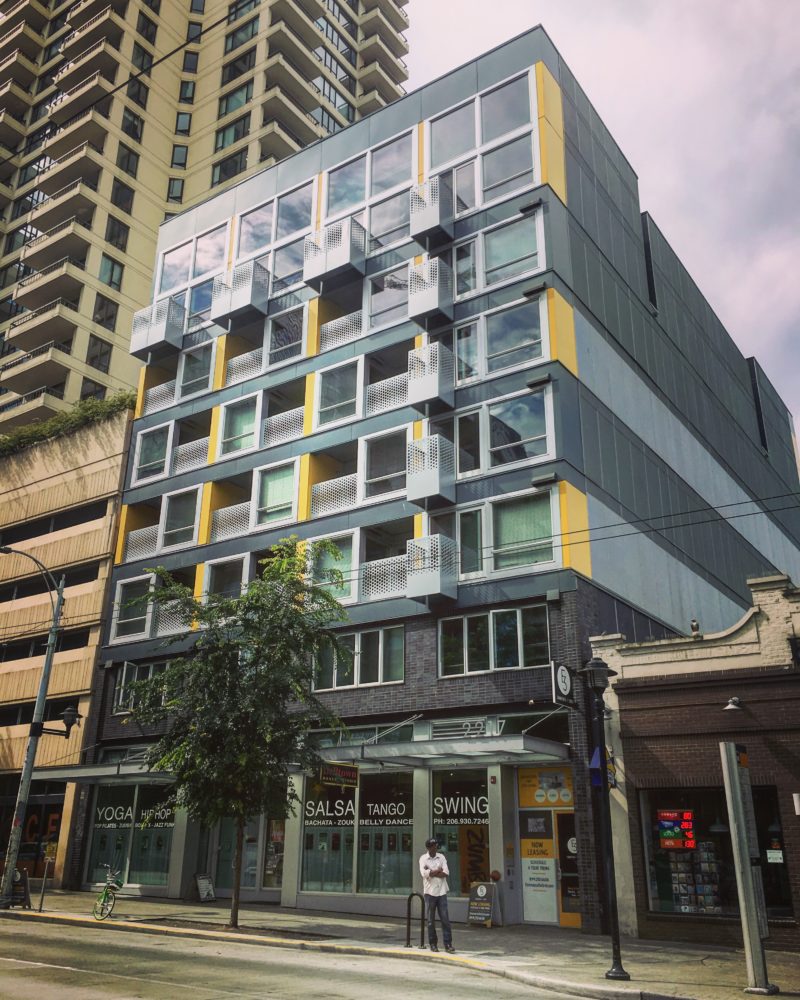[vc_row][vc_column][vc_column_text]Is the future of apartment construction indoors?
The costs of physical construction—the “hard costs”—are the single biggest determinant of the selling price or rent of a new home.
That’s the bet a number of modular construction companies in the Pacific Northwest are making. Building in Cascadia is expensive. Labor is scarce, and rents have surged since the last recession. Firms like Blokable, Katerra, and OneBuild say that by moving much of the process off building sites and onto factory floors, they can cut the cost of constructing multifamily housing by over half. They also say they can finish projects in half the time. If these claims prove true, these companies and other like them could shake up the housing industry in cities like Seattle, where the total cost to produce a single apartment home can surpass $300,000.
The costs of physical construction—the “hard costs”—are the single biggest determinant of the selling price or rent of a new home. If modular construction slashes hard costs, home-builders will make more homes—precisely what’s needed to control rising rents in cities facing housing shortages. Cutting hard costs also makes it possible to stretch public funds further, yielding more subsidized homes for low-income families as well.
So modular construction could be a housing affordability game-changer.
Tailor-made homes, tailor prices
Modular construction is hardly new. Mobile homes, a sister of modular housing, have been a popular form of inexpensive housing for decades, and single-family modulars have become a relatively cheap option for first-time homeowners and empty nesters who don’t need lots of space. What is new is the idea that modular construction methods can be used to revolutionize the entire construction industry. This could be especially true for apartments and condos—the productivity of which has barely increased since 1945, according to the McKinsey Global Institute—bringing down the cost of housing in the process.
To understand why multifamily housing construction is so expensive, it helps to know how it’s usually built. The conductor of the whole process is the developer—the business person who puts the deals together, securing funds from a bank or investors (or government or charitable agencies, for subsidized housing), and hiring professionals to design and construct the building. Typically, the developer selects a general contractor and that contractor, in turn, hires subcontractors who then often hire sub-subcontractors, and so on. Eventually, the contractor at the bottom of this chain actually does the work. Every layer of subs takes on some of the huge risk of a giant construction project but also drives up costs.
Meanwhile, construction labor is at a national premium in the United States, and even more so in Cascadia’s booming major cities. According to a recent analysis of affordable and market-rate multifamily construction costs in Portland, “a severe shortage of both skilled and unskilled labor in the PDX construction market” has led to cost escalation greater than the rest of the country.
Modular housing minimizes the layers of contractors, putting most or all of the construction processes under the control of one company.
This shortage boosts construction wages and the cost of housing. On top of that, many construction workers cannot afford to live in the expensive cities that need more housing the most, creating a vicious circle of rising rents exacerbated by a lack of a local workforce to build homes, and so on.
Modular housing minimizes the layers of contractors, putting most or all of the construction processes under the control of one company. It also standardizes everything it can, making home construction more like a modern, automated clothing factory and less like a tailor shop, where each garment is made by hand to custom specifications.
Some modular companies, like Katerra, build prefabricated components that can be put together quickly at a building site; others, like Blokable, manufacture entire apartments that just need to be stacked into place like Legos. But all have essentially the same mission statement: By eliminating some of the players and processes that make traditional housing expensive, modular boosters say, they can build more housing, faster, for less.
In any growing city’s housing market dance, home-builders pause when the stockpile of new homes pushes down rents to a level where it’s no longer profitable to build. But when costs can be cut—through cheaper construction methods like modular building or other cost-reducing measures—the no-build tipping point occurs at a lower rent. The result is more new homes get built, and rents drop that much further before home-building slows down. If modular construction can deliver anything like the savings its proponents project, it could take a giant bite out of rents and prices.
The same goes for the production of subsidized affordable housing, increasingly threatened across the US by the ongoing loss of federal and state funding. A big reduction in construction costs could enable non-profit developers to move projects forward with less public subsidy.

Katerra: The Ikeaization of home-building
One company that hopes to take all the guesswork out of modular construction—by controlling every aspect of the process—is Katerra, a Menlo Park, CA-based startup. It was founded on the idea that vertical integration is the best way to cut costs and eliminate surprises during design and construction. Katerra, which declined requests for an interview, is building a 250,000-square foot factory in Spokane Valley, where it will manufacture panels made of cross-laminated timber (CLT) and another mass-timber product called Glulam. Mass-timber products are composite materials made from scraps of wood and glue, and are strong enough to substitute for steel in high-rise buildings, allowing taller wood-framed buildings than can be built with ordinary lumber.

Once the factory is up and running, Katerra will be able to build CLT panels to order and snap them together on site, like flat-pack Ikea furniture panels that can be fitted together in a number of different configurations, allowing what the company calls “mass customization” using a predetermined, but customizable, kit of parts. Developers can specify everything from the size and configuration of the units to the finishes, and Katerra will build semi-custom components to order.
Katerra was founded just three years ago—by Michael Marks, the former CEO of electronics manufacturer Flextronics and interim CEO of Tesla; Jim Davidson, the founder of a private-equity firm; and Fritz Wolff, founder of national multifamily housing developer The Wolff Company. Now, it already has more than 1,300 employees in five states and four countries, and it recently raised $865 million from investors including SoftBank, a Japanese conglomerate. Katerra has also acquired a number of high-profile architecture and design firms, including Nystrom Olson in Spokane and Michael Green Architecture in Vancouver, BC.

Katerra has $1.3 billion in outstanding orders for new construction projects, including a handful of apartment buildings at various stages of design and construction in Oregon and Washington. (None have been completed so far.) Most of Katerra’s planned projects in Cascadia are located in suburban areas such as Kirkland (just east of Seattle) and Spokane Valley (to the east of Spokane, and close to Katerra’s planned CLT factory). Katerra plans to provide a range of services on each project. This includes architecture and engineering using Katerra’s standardized components (a 360-unit affordable housing complex in Snohomish County) to a full-service package that includes standardized CLT components (a 400-unit, under-construction market-rate project in Kirkland).

Blokable: A Lego approach to home-building
Aaron Holm, a former Amazon product manager and founder of the Vancouver, Washington-based modular builder Blokable, says the problem his company is trying to solve “is not to make more margin for general contractors or developers. It’s to make a dent in the housing problem.” In fact, Blokable is focusing on subsidized affordable housing, which the company says it can build at prices that are substantially lower than the $300,000 per unit that is often cited as the average cost of building affordable housing in Seattle.
Nelson Del Rio, Holm’s co-CEO, likens the layers of contractors on a conventional building project to hogs at a trough. “Every time we extract something out of that trough for [the hogs], … the end users, the working class, the people who can’t afford to live in town—they end up paying for it.”

If Katerra is like Ikea, Blokable is like Lego. Blokable’s steel-framed stackable apartments, fabricated at the company’s factory in Vancouver, WA, are standardized—35 feet by 9 feet on the outside, creating 260 square feet inside—making it easy for the company to truck them to a site, stack them, and connect them to the electrical and water grids. Unlike Katerra, which produces customized buildings composed of a standardized kit of parts manufactured off site, Blokable replicates largely identical units in its factory and pops the completed units into place on-site. The resulting homes are much cheaper than traditional apartments—about “$125,000 a door instead of $300,000 or $350,000,” Holm says.

Like most of the new modular companies, Blokable’s potential is still untested by the rigors of the real world. You cannot yet order a Blokable apartment building and have it show up at your building site, ready to snap together. But starting in July, visitors will be able to see a demonstration unit on land donated by the Edmonds Lutheran Church in a suburb near Seattle. The unit is part of a planned “village” of up to 70 affordable apartments that Blokable hopes to build within the next 24 months in collaboration with the Compass Housing Alliance, a nonprofit housing provider. A second project, in Auburn, WA, will include a dozen studio and one-bedroom units for people graduating from programs at Valley Cities Behavioral Health who would otherwise be at risk of homelessness.
Modular is no cure-all
One Cascadian modular company that has completed home-building is Seattle-based OneBuild. OneBuild has developed a half-dozen market-rate and affordable modular apartment buildings across western Washington. One example is the 49-unit ‘N’ Habitat Belltown building in downtown Seattle. Slipped into a 60-foot wide lot, the seven-story stack of modules was erected during two weekend road closures.
Others include Mod-19, with eight apartments in two buildings, located in a Seattle residential neighborhood; and the Vancouver, Washington Sylvan Park Senior Living Center, providing residential suites in four, three-story houses. The company manufactured the wood-framed modules for all of these projects at its factory in Klamath Falls, Oregon.
OneBuild provides a proof by existence that modular construction can work. OneBuild’s most recent experiences, however, also show that homebuilding is still a tough, complicated, and risky business.
To lower costs below what its Klamath Falls plant could do, OneBuild has sought to build its modular apartments in China, framed in steel instead of wood. Using a million-dollar gift from Microsoft co-founder Paul Allen in 2016, it launched a pilot project that would have housed 13 homeless families in steel units in south Seattle. But the project—which, like Blokable’s planned development in Edmonds, was a collaboration with Compass Housing—never got built.
In an interview with Seattle Times columnist Danny Westneat earlier this year, OneBuild founder and CEO Dale Sperling said overreaching inspectors forced expensive changes—like requiring larger water heaters—that made the project impossible. “These were to be temporary units, a three-year demonstration project,” Sperling told Westneat. “But there was one code hurdle after another. Finally, I had to pull the plug.” (Neither OneBuild nor Compass responded to requests for comment.)
OneBuild’s most recent experiences, however, also show that homebuilding is still a tough, complicated, and risky business.
Officials with the Seattle Department of Construction and Inspections, Seattle City Light, and the state Department of Labor and Industries—which got involved because OneBuild wanted to use prefabricated modular units from China—say Sperling’s plans simply violated their rules. Overseas (and even out-of-state) modular construction can lead to permitting problems when units do not conform with local regulatory requirements, such as minimum water heater sizes, fire and safety standards, and environmental requirements.
Meanwhile, foreign manufacturing may also stoke political pushback. Seattle City Council member Sally Bagshaw, who often mentions Blokable when the cost of building affordable housing comes up at council meetings, says she met with Sperling a few years ago, when he was just beginning to explore the idea of housing formerly homeless people in modular units. Bagshaw says she told Sperling, “‘I love the concept, I love what you’re doing, I’ve seen it done in other cities,’ but I said, ‘I can’t support you if you’re building in China. We need to be building them here.’” As the Pacific Northwest faces a housing shortage of epic proportions, concerns about the origin of modular units could be another roadblock to building the tens of thousands of affordable units the region needs.
OneBuild is proceeding with its Chinese steel modules for a planned 56-unit development in Bremerton, Washington, called InHabit Burwell. A spokeswoman with the city of Bremerton’s planning department says the project has received its site development permit and should be getting its building permit in the next few weeks.
Meanwhile, modular units in BC…
Modular construction is also starting to take off in greater Vancouver, BC. The city of Vancouver is halfway to its goal of building 600 temporary, low-cost, modular homes for homeless individuals and families. These include kitchenettes, private bathrooms, and rent for BC’s standard social assistance shelter rate of $375 a month. Unlike standard affordable housing, which may take two to three years to build, though, these modular units can typically be installed and occupied in 90 days.
On the market-rate side, first-time homebuyers and empty-nesters are fueling a boom in factory-built construction. Companies such as My Lane Home, which specializes in accessory dwelling units (or “laneway housing”); Moduline Homes, which builds more traditional single-family modular units; and Metric Modular, which focuses on Blokable-style off-site construction of stackable multifamily units, have contributed to a spike in modular construction across British Columbia.
Shoreline’s test run
Mark Ellerbrook, the regional housing and community development manager for King County, which includes Seattle, says he’s eager to see how some of the modular projects that are in development across the region pan out. “Can we really use this to deliver units at a lower cost, and/or in a quicker way, to begin to address the housing shortage? The short answer is that we don’t know, but we are going to pilot some options to see if in fact it does hold promise.”
King County just issued a request for qualifications for modular housing companies to build approximately 65 affordable housing units on land owned by the city of Shoreline.
One of those projects will be on land owned by the city of Shoreline, just north of Seattle; King County just issued a request for qualifications (RFQ) for modular housing companies to build approximately 65 affordable housing units on the site. Other than the modular component, the RFQ is for a traditional construction project, with a separate builder, architect, and general contractor, so it won’t be a test of the vertically integrated business model piloted by companies like Blokable and Katerra. Still, it could provide a glimpse into the future of modular construction, and a reality check on what’s possible in the short term. “While the very first project we do this way may not ultimately deliver on all the promises, in terms of cost, speed, and replicability, we will learn some things, and we will be able to do it more affordably in the future,” Ellerbrook says.
Can modular housing deliver?
The modular promise is big: cutting construction costs in half would be a game changer for housing affordability in booming cities throughout North America. The acceleration of home-building it would catalyze would pull down rents and prices, benefiting all residents who buy or rent market-rate homes. And it would be a major boost to non-profit affordable housing developers as well, helping them get more out of limited public funds to create more subsidized homes for people who can’t afford what the market can provide.
Moving most of the home manufacturing process to remote factory sites outside of expensive cities also has the potential to fix the wicked problem of construction workers not being able to afford to live where they work, which squeezes the availability of labor, which raises construction costs, which in turn makes those cities even less affordable to workers. The full potential for modular home construction is massive, so it’s worth keeping an eye on pioneers like Katera, Blokable, and OneBuild. [/vc_column_text][/vc_column][/vc_row]



Comments are closed.